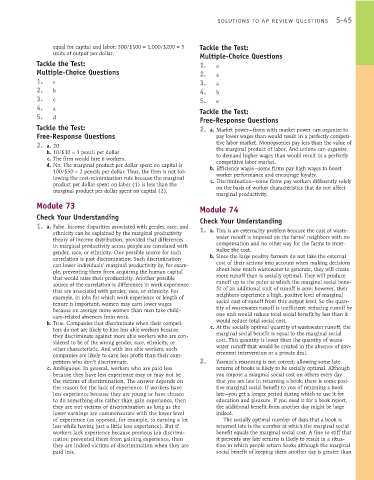Page 891 - Krugmans Economics for AP Text Book_Neat
P. 891
S-45
SOLUTIONS TO AP REVIEW QUESTIONS
equal for capital and labor: 500/$100 = 1,000/$200 = 5 Tackle the Test:
units of output per dollar. Multiple-Choice Questions
Tackle the Test: 1. a
Multiple-Choice Questions 2. a
1. c 3. a
2. b 4. b
3. c 5. e
4. a Tackle the Test:
5. d
Free-Response Questions
Tackle the Test: 2. a. Market power—firms with market power can organize to
Free-Response Questions pay lower wages than would result in a perfectly competi-
tive labor market. Monopsonies pay less than the value of
2. a. 20 the marginal product of labor. And unions can organize
b. 10/$10 = 1 pencil per dollar
c. The firm would hire 6 workers. to demand higher wages than would result in a perfectly
d. No. The marginal product per dollar spent on capital is competitive labor market.
100/$50 = 2 pencils per dollar. Thus, the firm is not fol- b. Efficiency wages—some firms pay high wages to boost
worker performance and encourage loyalty.
lowing the cost-minimization rule because the marginal
product per dollar spent on labor (1) is less than the c. Discrimination—some firms pay workers differently solely
on the basis of worker characteristics that do not affect
marginal product per dollar spent on capital (2).
marginal productivity.
Module 73 Module 74
Check Your Understanding
Check Your Understanding
1. a. False. Income disparities associated with gender, race, and
ethnicity can be explained by the marginal productivity 1. a. This is an externality problem because the cost of waste -
theory of income distribution, provided that differences water runoff is imposed on the farms’ neighbors with no
in marginal productivity across people are correlated with compensation and no other way for the farms to inter-
gender, race, or ethnicity. One possible source for such nalize the cost.
correlation is past discrimination. Such discrimination b. Since the large poultry farmers do not take the external
can lower individuals’ marginal productivity by, for exam- cost of their actions into account when making decisions
ple, preventing them from acquiring the human capital about how much waste water to generate, they will create
that would raise their productivity. Another possible more runoff than is socially optimal. They will produce
source of the correlation is differences in work experience runoff up to the point at which the marginal social bene-
that are associated with gender, race, or ethnicity. For fit of an additional unit of runoff is zero; however, their
example, in jobs for which work experience or length of neighbors experience a high, positive level of marginal
tenure is important, women may earn lower wages social cost of runoff from this output level. So the quan-
because on average more women than men take child- tity of wastewater runoff is inefficient: reducing runoff by
care-related absences from work. one unit would reduce total social benefit by less than it
b. True. Companies that discriminate when their competi- would reduce total social cost.
tors do not are likely to hire less able workers because c. At the socially optimal quantity of waste water runoff, the
they discriminate against more able workers who are con- marginal social benefit is equal to the marginal social
sidered to be of the wrong gender, race, ethnicity, or cost. This quantity is lower than the quantity of waste-
other characteristic. And with less able workers, such water runoff that would be created in the absence of gov-
companies are likely to earn less profit than their com- ernment intervention or a private deal.
petitors who don’t discriminate. 2. Yasmin’s reasoning is not correct: allowing some late
c. Ambiguous. In general, workers who are paid less returns of books is likely to be socially optimal. Although
because they have less experience may or may not be you impose a marginal social cost on others every day
the victims of discrimination. The answer depends on that you are late in returning a book, there is some posi-
the reason for the lack of experience. If workers have tive marginal social benefit to you of returning a book
less experience because they are young or have chosen late—you get a longer period during which to use it for
to do something else rather than gain experience, then education and pleasure. If you need it for a book report,
they are not victims of discrimination as long as the the additional benefit from another day might be large
lower earnings are commensurate with the lower level indeed.
of experience (as opposed, for example, to earning a lot The socially optimal number of days that a book is
less while having just a little less experience). But if returned late is the number at which the marginal social
workers lack experience because previous job discrimi- benefit equals the marginal social cost. A fine so stiff that
nation prevented them from gaining experience, then it prevents any late returns is likely to result in a situa-
they are indeed victims of discrimination when they are tion in which people return books although the marginal
paid less. social benefit of keeping them another day is greater than

